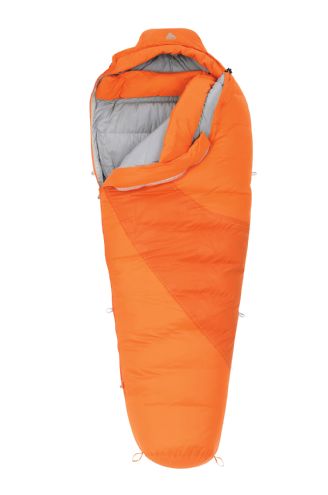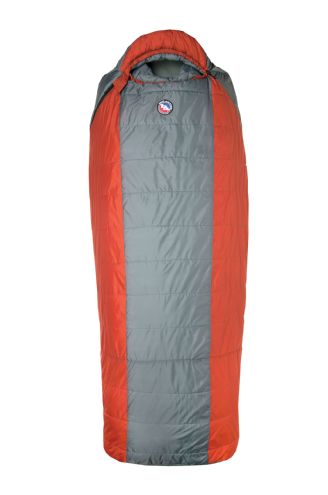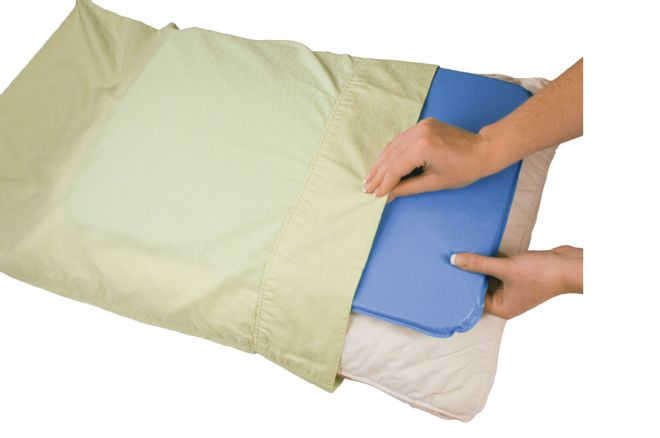There was a time, not long ago, when a sleeping bag with flannel was considered futuristic technology. But now, bags got tech. Serious tech. Or as Chris Burston from Sport Chalet explained to us, “Advancements in technology range from draft tubes to block wind, to bags with varying insulation levels that can cover the needs of women around the torso and feet.” So, no flannel? Also, they’re often no longer unisex. Sometimes they’re seasonal. Expelling moisture is a big deal (the flannel bag? Not so much). And weirdly, but conveniently, you can even walk around wearing your sleeping bag. But before you decide which sleeping bag is right for you, sort out what time of year you’ll be going and where you’ll need it. For example, hot or dry temps benefit from down-based bags, although they tend to be more spendy. Synthetic bags are a little heavier, but they do better in wet weather. Mummy bags are known for extra warmth and being lighter in weight, while rectangular cut tends to equal more roominess. Here’s a look at what’s hot right now when it comes to sleeping on the ground.
Selk’bag
selkbagusa.com
Weight: Starts at 2.9 lbs (Lite)
Temperature Rating: 45 degrees Fahrenheit (Lite)
Price: Starts at $99 (Lite)
“Isn’t it cool that you can separate, move, and join arms and legs so you can have a restful and warm sleep, and at the same time, you can stand without any trouble, walk, cross your legs, and grab things without leaving the coziness of your sleeping bag? Well, that’s the idea of the Selk’bag.” That was Selk’bag co-founder Cristobal Murillo. The Selk’bag is designed to replace the sleeping bag, making it more of a sleeping-and
-wide-awake bag. Or a “sleepwear system.” Cristobal noted that a misconception about a wearable sleeping bag is that it can’t possibly be as warm as a regular sleeping bag since you don’t have your arms around your body. However, the technology is, in many ways, the same as sleeping bags -- there’s a temperature rating, special insulation, and comfortable materials. There are various models of Selk’bag, with the most advanced being the Patagon, which is ideal for outdoor use year-round, and has detachable booties, meaning you can wear your own shoes. But isn’t the Selk’bag just an outdoor version of the Snuggie? “Let’s put it this way,” Cristobal explained. “If you like a ‘91 Honda, the Snuggie is for you.” He’s saying, if you’d rather have the most innovative, trendy vehicle you could get today, the Selk’bag is for you. So, a ’14 Honda?

| Kelty Ignite Down 20
Kelty Ignite Down 20
sportchalet.com
Weight: 2 lbs, 12 oz
Temperature Rating: 20 degrees Fahrenheit
Price: Starts at about $220
This line of sleeping bags is comprised of three-seasoners, meaning it’s ideal spring, summer, and fall. The Ignite Down has been tested for 16 degrees Fahrenheit at the lower limit and 28 degrees Fahrenheit for comfort (yes, there’s a real standardized scientific test for determining the true temp rating of a bag). It also utilizes DriDown technology, “which shows the evolution of down insulation,” said Sport Chalet’s Chris Burston. “The DriDown finish to each plume of the bag allows for a drier, more comfortable experience because, if wet and without DriDown, the bag will lose its loft and warmth.” Also, the Ignite Down is hyper convenient as down insulation is lightweight, so it squishes into nearly nothing when you’re packing gear. And the Ignite Down comes in male and female versions; the girl bags are often wider in the hips and have more insulation in places like the torso and feet.

| Big Agnes Hog Park
Big Agnes Hog Park
bigagnes.com
Weight: 5 lbs, 11 oz
Temperature Rating: 20 degrees Fahrenheit
Price: About $170
The Hog Park is another three-season bag (spring, summer, and fall), and the heart of it is the sleep system, which means a sleeve on the bottom for the sleeping pad. “This creates an integrated sleeping bag and pad, so you never have to worry about slipping or rolling off your sleeping pad in the middle of the night,” said Katie Hughes, marketing specialist for Big Agnes. “As an added benefit, the bag is lighter and it holds in heat more effectively.” DownTek water-repellent down and synthetic Thermolite Quallofill maintains heat, even if the bag gets wet. Added Katie, “One interesting design in our new bags is a vertical baffling design where the stitching and baffles run from the top to the bottom of the bag. This makes heat transfer from the warm areas of the body (your core) to the footbox and up around the head, so the overall feel of the bag is warmer. This prevents cold spots and keeps the user’s feet warmer.”
“
When shopping for a sleeping bag, consider first whether a down or synthetic bag is preferred. Synthetics tend to be durable, will keep you warm in damp/wet conditions, but are a bit heavier than down. Down bags are typically lighter, pack smaller, and as a result, tend to be more expensive.”
-- Katie Hughes, Big Agnes

| Chillow Cooling Pillow
And…Chillow?
You’ve got your body covered while camping, but what should you do with your head? Meet the Chillow (chillow.com), a cooling pillow. Explained Chillow expert Sonia Markurdsk, “Chillow is activated simply by adding water to its inner chamber, after which a cup of water may need to be added monthly depending on climate and room temperature. Chillow can be customized to four different cooling comfort levels to satisfy personal needs. Once its temperature is set, it stays at that level and provides cooling relief.” What makes it a nice addition to your camping gear isn’t only that it’s $12.99, it’s that it can provide coolness for muscle soreness from hiking all day, a headache, tired feet, heat, or bug bites (sure, you can use an ice pack, but it will eventually turn into a water pack). Plus, a regular pillow traps heat. Hey, what about a version that’s a sleeping bag? Like a Chilling Bag? “Yes, we are working on other line extensions for the brand,” Sonia revealed.
 | Kelty Ignite Down 20
Kelty Ignite Down 20
sportchalet.com
| Kelty Ignite Down 20
Kelty Ignite Down 20
sportchalet.com
 | Big Agnes Hog Park
Big Agnes Hog Park
bigagnes.com
| Big Agnes Hog Park
Big Agnes Hog Park
bigagnes.com
 | Chillow Cooling Pillow
And…Chillow?
You’ve got your body covered while camping, but what should you do with your head? Meet the Chillow (chillow.com), a cooling pillow. Explained Chillow expert Sonia Markurdsk, “Chillow is activated simply by adding water to its inner chamber, after which a cup of water may need to be added monthly depending on climate and room temperature. Chillow can be customized to four different cooling comfort levels to satisfy personal needs. Once its temperature is set, it stays at that level and provides cooling relief.” What makes it a nice addition to your camping gear isn’t only that it’s $12.99, it’s that it can provide coolness for muscle soreness from hiking all day, a headache, tired feet, heat, or bug bites (sure, you can use an ice pack, but it will eventually turn into a water pack). Plus, a regular pillow traps heat. Hey, what about a version that’s a sleeping bag? Like a Chilling Bag? “Yes, we are working on other line extensions for the brand,” Sonia revealed.
| Chillow Cooling Pillow
And…Chillow?
You’ve got your body covered while camping, but what should you do with your head? Meet the Chillow (chillow.com), a cooling pillow. Explained Chillow expert Sonia Markurdsk, “Chillow is activated simply by adding water to its inner chamber, after which a cup of water may need to be added monthly depending on climate and room temperature. Chillow can be customized to four different cooling comfort levels to satisfy personal needs. Once its temperature is set, it stays at that level and provides cooling relief.” What makes it a nice addition to your camping gear isn’t only that it’s $12.99, it’s that it can provide coolness for muscle soreness from hiking all day, a headache, tired feet, heat, or bug bites (sure, you can use an ice pack, but it will eventually turn into a water pack). Plus, a regular pillow traps heat. Hey, what about a version that’s a sleeping bag? Like a Chilling Bag? “Yes, we are working on other line extensions for the brand,” Sonia revealed.